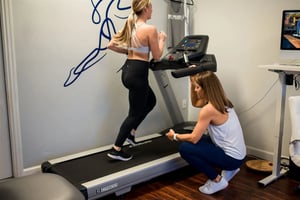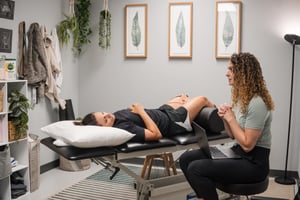Why Resilience Matters for Runners Running is one of the most popular forms of exercise in the...
The Connection Between Mobility, Strength, and Running Efficiency
Running efficiency isn’t just for elite athletes chasing race-day PRs. Whether you're training for a 5K or enjoying weekend miles on the trails, how efficiently your body moves affects everything—speed, endurance, and injury risk.
Efficient runners use less energy to maintain pace. Their strides are smoother, their form is more controlled, and their bodies absorb and redirect force with minimal waste. Inefficient runners, on the other hand, often rely on compensations—overstriding, excess muscle recruitment, or poor posture—that create stress, slow progress, and increase the chance of overuse injuries.
READ: Why Your Hamstring Rehab Isn’t Complete Until You Train Speed.
Improving running efficiency doesn’t just make running feel easier—it helps you run longer, recover faster, and stay pain-free.
At Core Values in Winter Garden, we help runners uncover what’s holding them back—often, it comes down to two things: mobility and strength.
Mobility: The Foundation for Natural, Pain-Free Movement
Mobility is your body’s ability to move freely through its full range of motion without restriction. For runners, this means having the flexibility and joint control needed to stride, rotate, and absorb impact smoothly—without forcing other areas to compensate.
When mobility is limited, your body finds workarounds. Tight hips? Your knees or lower back may take on more stress. Limited ankle dorsiflexion? You might overstride or lose push-off power. Over time, these compensations reduce efficiency and increase injury risk.
Efficient running starts with mobile hips, ankles, and thoracic spine—all areas that support fluid, natural motion. But mobility isn’t just about being flexible. It’s about having control within your range so that your joints are stable and responsive through every phase of your stride.
At Core Values, we assess these patterns directly. Whether you’re a recreational runner or logging serious miles, unlocking your mobility can lead to smoother, more efficient runs—and fewer flare-ups along the way.
Strength: Stability That Powers Every Step
Mobility gives you range—but strength gives you control. In running, strength is what stabilizes your joints, absorbs impact, and propels you forward with power and efficiency.
READ: 🏃♂️ How We Use the LEVER Body Weight Support System at Core Values PT (and Why It Works)
Many runners underestimate how much strength matters. It’s not just about lifting weights—it’s about building stability in key muscle groups that support running mechanics: the glutes, hips, core, and lower legs. When these areas are strong, your body stays aligned under load. When they’re weak, you’re more likely to collapse through your stride, overuse certain muscles, or lose force with every step.
For example, weak hip stabilizers can lead to knee valgus (inward collapse), which is a common contributor to patellofemoral pain or IT band issues. A weak core can cause excessive trunk movement, which not only wastes energy but can also strain the lower back.
Strength training isn’t optional if you want to improve your running efficiency—it’s essential. At Core Values, we incorporate strength work that complements running, helping athletes in Winter Garden move with more confidence, stability, and speed.
The Synergy Between Strength and Mobility
Mobility and strength don’t work in isolation—they enhance one another. When both are developed together, they create the foundation for efficient, resilient movement. When one is lacking, the other can only compensate for so long.
For example, good hip mobility allows your leg to swing through with ease—but without the strength to stabilize your pelvis, that mobility can become inefficient or even lead to injury. Likewise, a strong glute won’t do much if your hip joint is so restricted that you can’t use your full stride.
Running
efficiently requires a balance: mobility gives you access to movement, and strength gives you the ability to control it under stress. Together, they reduce energy leaks, improve posture, and allow for smoother, more consistent form.
At Core Values, we assess both elements side-by-side. If you’re stretching constantly but still feel tight, or if you’re strong but always dealing with little aches and pains, it may be a sign that your system isn’t in sync. Strength and mobility must be developed together to truly elevate how you move.
How Core Values Supports Runners in Winter Garden
At Core Values in Winter Garden, we take a comprehensive approach to running performance and injury prevention. We don’t just treat symptoms—we identify and address the movement patterns that impact your efficiency and comfort over time.
Our Running Physical Therapy services and Resilient Runner Program are built around the connection between mobility, strength, and running mechanics. Whether you’re recovering from an injury or looking to shave seconds off your mile time, we start with a full-body movement assessment to pinpoint exactly where you're limited—and why.
READ: Winter Garden's Guide to Dry Needling
From there, we build a personalized plan that may include mobility drills, strength training, dry needling, or sport-specific movement coaching. We also offer CrossFit Movement Assessments for athletes whose running is part of a broader performance routine.
Runners in Winter Garden don’t need to train harder to improve—they need to train smarter. At Core Values, we’re here to help you move more efficiently, perform at your best, and stay healthy for the miles ahead.



